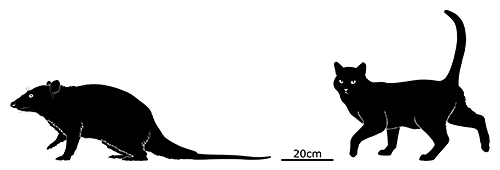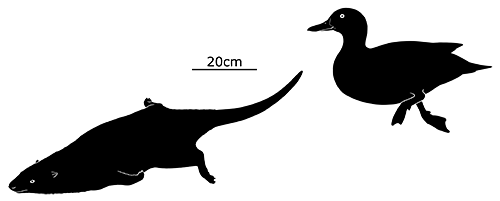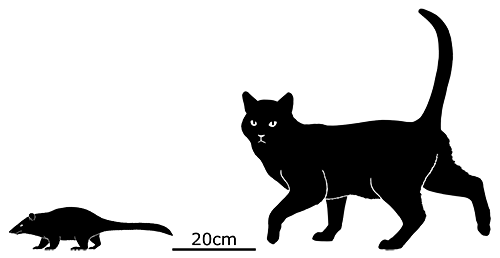It’s time for a little bit more recent PBS Eons work this week:
• The metatherian predator Arctodictis and the litoptern ungulate Thoatherium from “The Mystery of South America’s False Horses”
Paleontology and science illustration, and feathering ALL the dinosaurs
It’s time for a little bit more recent PBS Eons work this week:
• The metatherian predator Arctodictis and the litoptern ungulate Thoatherium from “The Mystery of South America’s False Horses”
Towards the end of the Cretaceous, about 69 million years ago, the most diverse and numerous mammals in the northern hemisphere were the metatherians, close relatives of modern marsupials.
And Unnuakomys hutchisoni was the most northern-living of all these metatherians.
About the size of a modern mouse, around 10-15cm long (4-6″), and with teeth that suggest it was a shrew-like insectivore, this little metatherian lived in northern Alaska in what’s known as the Paaŋaqtat Province – a region with a distinctive population of endemic polar animals. At the time this area was located at an even higher latitude than it is today, around 80-85ºN, but due to a greenhouse climate it was also warmer, with no permanent ice and the average temperatures staying above freezing.
Unnuakomys was by far the most common mammal species in the Paaŋaqtat Province, represented by numerous fossil teeth and a few jaw fragments, and it also seems to have been the only metatherian living in the whole region. This may just be a preservation bias in the fossil record, but it might also indicate that Unnuakomys was uniquely specialized to endure the several months of continuous darkness each winter in its polar woodland environment, while other North American metatherians were restricted to more southerly latitudes.
Gliding has convergently evolved multiple times within mammals, from the Jurassic-aged haramiyids and volaticotheres to numerous species of modern marsupials, rodents, and colugos.
And yet despite the huge diversity of gliding mammals, and their particular prevalence in tropical forests, there’s an entire continent famous for its rainforests that’s somehow completely lacking any modern examples: South America.
It’s not clear why the gliding lifestyle never took off in South America, but the continent is surprisingly devoid of any other gliding vertebrates, too. The only exceptions are a few species of flying frogs in the northwestern tropical forests around Colombia.
But back in the early Eocene, about 53-50 million years ago, there was at least one South American gliding mammal. Some fossil limb bones found in the Itaboraí Formation in southeastern Brazil look very much like those of a gliding mammal – long and thin, with a locking elbow joint, knees adapted for jumping, and flexible ankles typical of tree-climbers.
These remains haven’t been given a new scientific name, however, because there’s a good chance they belong to an already-described species. Fossils from Itaboraí are found disarticulated, broken, and with bones of multiple different species jumbled together, so most fossil mammals named from the site have been based on their more easily distinguishable teeth and jaw fragments.
The problem is matching those teeth with these bones.
Currently the best identity guess based on size is Gaylordia macrocynodonta. This mammal would have been around 30cm long (1′), about the size of a modern rat, and had distinctive large canine teeth. It used to be classified as a marsupial related to opossums, but more recent studies have found it to have actually been a marsupialiform metatherian instead, much more closely related to Pucadelphys and sparassodonts than to any modern true marsupials.
Gaylordia‘s crushing molars suggest it was carnivorous, able to crunch through bones or hard-shelled invertebrate prey. This would be a very unusual diet for a gliding mammal, since most other mammalian gliders are herbivores or omnivores – the only other known predatory examples were the volaticotheres over 110 million years earlier.
It’s another PBS Eons commission roundup day!
The metatherian mammals Pucadelphysand Khasia, and lineart of the sparassodont Paraborhyaena, from “How South America Made the Marsupials”
https://www.youtube.com/watch?v=l5doyrUWFbE
The dyrosaurid crocodyliform Acherontisuchus and the bothremydid turtle Puentemys, from “How a Hot Planet Created the World’s Biggest Snake”
https://www.youtube.com/watch?v=T-hDNbM-WLk
The early penguin Waimanu and the giant penguin Anthropornis, from “When Penguins Went From The Sky To The Sea”
https://www.youtube.com/watch?v=HMArjGQwLvY
The Pontide island 43 million years ago had no placental mammalian carnivores, and in their absence a different type of mammal took up the main predatory niches – the metatherians.
Metatherians today are represented solely by marsupials, but there were once many other branches of this mammal lineage. One group present in Europe for much of the Cenozoic were the herpetotheriids, and these rat-sized animals seem to have also occupied the small predator and opportunistic omnivore niches on the Pontide island.
And then there were the bigger metatherians.
Anatoliadelphys was a specialized carnivore, with strong jaws and bone-crushing teeth similar to the modern Tasmanian devil. It had a body size similar to a domestic cat, giving it a total length of up to 1m long (3′3″), and had opossum-like grasping digits and a prehensile tail indicating it was capable of climbing trees.
It was initially thought to be descended from another type of metatherian found in Europe at the time, the peradectids, but a later study came up with a more surprising result for its evolutionary relationships. It instead may be closer related to the polydolopimorphs, a group known mainly from South America. Quite how its ancestors got as far as Turkey is a bit of a mystery, but it’s possible they’d previously dispersed into Africa at a time when the continents were still much closer to each other than they are today, and then spread northwards until they reached the Pontide island.
The main problem with this hypothesis is the current lack of any polydolopimorphans in the African fossil record – but the African Eocene is still poorly understood, so there may be some metatherian fossils yet to be discovered that could fill in this gap.

Along with the marsupials and the polydolopimorphs, the sparassodonts were one of the lineages of metatherian mammals that inhabited South America during its “great isolation” for most of the Cenozoic. And despite having to share the large carnivore niches with both the terror birds and the sebecosuchian crocs, they still managed to become the main mammalian predators of the region.
Their first definite fossils come from the start of the Paleocene (~65 mya), but they probably actually originated sometime in the Late Cretaceous before the mass extinction. A currently-unnamed skull from Mongolia (~70 mya) appears to be either an early sparassodont or a very close relative, and a North American metatherian called Varalphadon (~90 mya) may also be linked to the group. It’s possible that, like the marsupials, they may have first evolved in North America and later spread into South America before it became isolated.
Like their marsupial relatives they would have given birth to tiny undeveloped young, although we don’t know for certain if they actually had pouches or not. Their epipubic bones were highly reduced, so it’s possible they didn’t have pouches – but they also might have had mostly cartilaginous epipubics (like thylacines) that just didn’t fossilize.
Over the course of the Cenozoic the sparassodonts convergently evolved many similar features to placental carnivorans, with carnassial teeth for shearing through flesh and a wide variety of body shapes ranging from small weasel-like forms to long-snouted ambush hunters to large hyaena-like bone-crushers.
But by far the most famous members of the group were the thylacosmilids. First appearing in the Early Miocene, about 20-15 million years ago, these sparassodonts developed huge elongated canine teeth that resembled those of sabertoothed cats. Unlike the felid sabertooths, however, thylacosmilids’ fangs grew continuously and their lower jaws had long bony flanges that supported and protected their teeth when theirs jaws were closed.
Thylacosmilus atrox was the last and most highly specialized of the thylacosmilids, living from the Late Miocene to the Late Pliocene, around 9-3 million years ago. About 1.2-1.5m long (~4-5′) and standing 60cm tall at the shoulder (2′) it was similar in size to a modern jaguar – not huge compared to some placental predators, but still one of the largest of all known carnivorous metatherians.
Despite its huge fangs it actually had a fairly weak bite force, instead relying on its strong forelimbs to immobilize its prey before delivering precise deep stabs into soft body parts using powerful neck muscles. The structure of its limbs also suggests it wasn’t a fast runner, and it probably had to stalk or ambush its targets.
Although the extinction of Thylacosmilus and the other last sparassodonts is often blamed on being out-competed by similar placental carnivores arriving during the Great American Interchange, it seems like that wasn’t actually the case. Many of their northern placental equivalents such as Smilodon didn’t enter South America until the mid-Pleistocene (~1-0.7 mya), over 1.5 million years after the last record of any living sparassodonts. So it’s likely they never actually met each other, and the disappearance of the sparassodonts may be more linked to cooling climates in the Pliocene and early Pleistocene.
While the opossum-like herpetotheriids and peradectids survived in the northern continents for most of the Cenozoic, a wider variety of metatherian mammals were found in the south. Alongside the true marsupials and the sparassodonts, a group known as the polydolopimorphs existed in South America for over 60 million years. Although most of the their fossil remains consist only of isolated teeth and jaw fragments, they seem to have been a very diverse group that adapted to a wide range of ecological niches including insectivores, herbivores, and fruit-eating and seed-eating specialists.
Their exact evolutionary position within the metatherians is still rather unclear and under dispute, with different studies giving different results. They were probably marsupialiformes, slightly less closely related to marsupials than the herpetotheriids, but some paleontologists instead consider them to have been true marsupials related to either the shrew opossums or the microbiotheres. (And some go with both options, proposing that they weren’t even a natural group but were polyphyletic, with some being marsupialiformes and others being true marsupials.)
The earliest definite polydolopimorph fossils come form the very start of the Paleocene in South America (~66 mya), but their lineage likely goes further back into the Late Cretaceous – possible remains from North America suggest they may have originated there at least 70 million years ago, with their ancestors migrating into South America shortly before the end-Cretaceous extinction. A few also reached Antarctica by the Late Eocene (~40-33 mya), before the continent had fully separated from its neighbors and frozen over, but it’s unclear whether any ever made it as far as Australia alongside their marsupial relatives.
They were most diverse during the first half of the Cenozoic, and in the latter half they were represented mainly by a highly specialized lineage called the argyrolagids. Known from western and southern South America (Peru, Bolivia, Argentina, and Chile) from the Early Oligocene onwards, these polydolopimorphs were convergently rodent-like desert herbivores with short forelimbs and long hopping hindlimbs that gave them a resemblance to jerboas or springhares.
Argyrolagus palmeri here lived during the Early Pliocene of Argentina (~5-3.5 mya). About 40cm long (1′4″), it had only two toes on its feet, a long pointed snout, and large eyes and ears that indicate it was probably nocturnal.
These last polydolopimorphs survived until at least the end of the Pliocene, around 2.5 million years ago. Their disappearance coincides with the time of the Great American Interchange – when South America became connected to Central and North America – and they may have been some of the victims of the extinction caused by the influx of placentals from the north.
While modern marsupials are native only to Australasia and the Americas, they’re part of a larger grouping of mammals known as metatherians that were once found around most of the world. Thought to have originated in Asia, perhaps as far back as the Late Jurassic (~160 mya), the ancestral metatherians spread to Europe and the Americas during the Cretaceous and gave rise to multiple different lineages, ranging from small sabertoothed carnivores to otter-like swimmers to the main mammalian predators of Cenozoic South America.
True marsupial fossils didn’t appear in the fossil record until the start of the Paleocene (~65 mya), but some of their closest evolutionary “cousins” – the herpetotheriids – originated a little earlier in the Late Cretaceous, around 70-66 million years ago.
Herpetotheriids were small opossum-like animals found in North America, Asia, Europe, and Africa. They were more terrestrial than the opossums they resembled, adapted for running on the ground rather than climbing, but were probably similarly opportunistic omnivores eating a wide variety of foods.
They survived through the end-Cretaceous extinction and seem to have actually been quite common in the northern continents for most of the Cenozoic. They also weren’t the only metatherians in those regions, living alongside another group called the peradectids which were true marsupials closely related to opossums.
In North America the native metatherians all went extinct sometime around the early Miocene (~20 mya) – although the continent would later be recolonized by opossums from South America during the Great American Interchange. Meanwhile the African herpetotheriids disappeared around the same time, but the European and Asian metatherians continued on into a little longer into the mid-Miocene.
Amphiperatherium frequens was one of the last known members of the herpetotheriids, living in Europe during the early-to-mid Miocene (~20-13 mya). It was about the size of a small rat, around 15-20cm long (6-8″), and seems to have mainly inhabited warm humid environments.
Although the disappearance of the northern metatherians has traditionally been blamed on them being out-competed by placental mammals, the fact that they survived alongside placentals just fine for over 45 million years suggests that something else pushed them over the brink. Their extinction may in fact be more linked to the ongoing drying and cooling climate trends in the latter half of the Cenozoic.
The herpetotheriid’s extinction seems to have happened soon after the Middle Miocene disruption, a sudden shift towards cooler temperatures that may have altered their local ecosystems too quickly for them to adapt. The peradectids hung on until at least 11 million years ago, with some of the last members known from Southeast Asia, but they may have likewise fallen victim to further episodes of global cooling towards the end of the Miocene and into the Pliocene.
While true marsupials didn’t appear in the fossil record until the early Cenozoic, some of their closest relatives in the Mesozoic were a group called stagodontids. These metatherians evolved in North America during the Late Cretaceous, and much like the deltatheroideans seem to have taken over some of the ecological niches left vacant after the extinction of most eutriconodonts.
Their strong jaws and large blunt premolar teeth were adapted for crushing hard-shelled food, and they seem to have been semi-aquatic swimming animals (somewhat similar to modern water opossums) specialized for eating freshwater invertebrates such as snails and crustaceans.
Most stagodontids went extinct during the end-Cretaceous mass extinction, but if the early Cenozoic genus Eobrasilia is a member of the group then at least some survived in South America up until about 52 million years ago.
Other metatherians persisted in Europe, Africa, and Asia for most of the Cenozoic, with some fossils dating to just 11 million years ago, and the sparassodonts were successful in South America until about 3 million years ago – but today the only living members of this branch of the therian lineage are the marsupials in the Americas and Australasia.

Didelphodon was a stagodontid living during the Late Cretaceous of North America (70-66 mya), and is known from skull and jaw remains, along with a fairly complete skeleton that hasn’t been officially described yet.
It had a long otter-like body and flexible feet, adaptations for efficient swimming, and was one of the largest known mammals at the time, measuring around 1m in length (3′3″).
Its sturdy jaws had an especially powerful bite force, one of the strongest relative to body size known for any mammal, and some of its molars were blade-like and similar in appearance to carnassials. Along with crunching on shellfish it would also have been capable of crushing bones and tough plants, and its diet was probably an omnivorous mixture of invertebrates, vegetation, carrion, and small vertebrates – potentially including other mammals and small dinosaurs.

In modern times the therian mammals are represented by just two surviving groups – placentals and marsupials. But both of these lineages contained many other extinct close relatives, and this final week of the month will focus on a few of them.
Modern marsupials are part of a larger grouping known as metatherians which split off from their common ancestor with placentals during the Jurassic period, at least 160 million years ago. Probably originating in Asia, they spread to Europe and the Americas during the Cretaceous, and diversified into several different groups – including some which would go on to become the dominant mammalian predators in South America during its long period of isolation in the Cenozoic.
One of the earliest branches of the metatherians were the deltatheroideans. These mammals are known from Asia and North America, evolving to fill vacant small carnivore niches after the disappearance of most of the eutriconodonts. Most of them went extinct at the end of the Cretaceous, but a few did survive for at least 10 million years afterwards.

Lotheridium was a deltatheroidean living during the Late Cretaceous of China (72-66 mya), and is known from a nearly complete skull. It’s likely to have had a head-and-body length of about 20cm (8″), and may have had a full length including the tail of up to 30-40cm (1′-1′4″).
It had elongated canine teeth, convergently similar to the saberteeth of many later mammal groups. It was probably a highly specialized predator, and may even have been capable of preying on small dinosaurs – its close relative Deltatheridium is known to have eaten theropods like Archaeornithoides.
